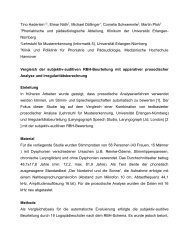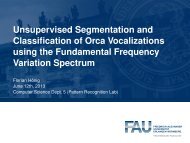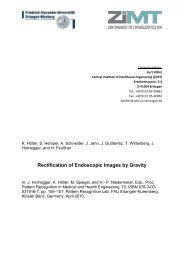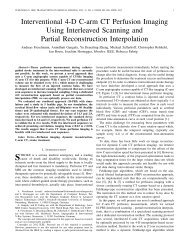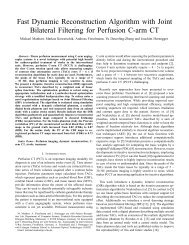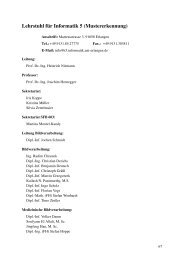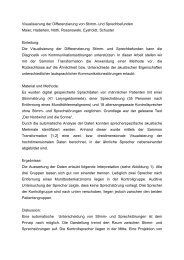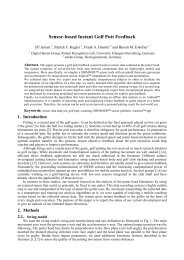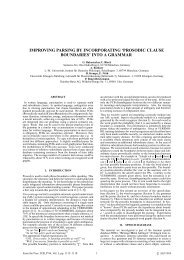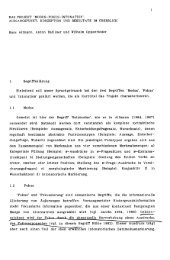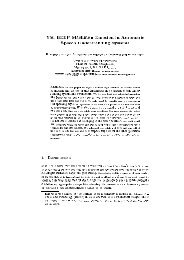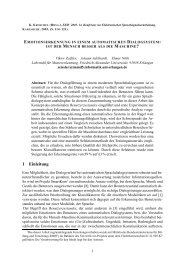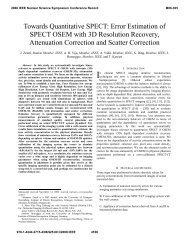Matthias Zobel, Joachim Denzler, Benno Heigl, Elmar Nöth, Dietrich ...
Matthias Zobel, Joachim Denzler, Benno Heigl, Elmar Nöth, Dietrich ...
Matthias Zobel, Joachim Denzler, Benno Heigl, Elmar Nöth, Dietrich ...
Create successful ePaper yourself
Turn your PDF publications into a flip-book with our unique Google optimized e-Paper software.
<strong>Matthias</strong> <strong>Zobel</strong>, <strong>Joachim</strong> <strong>Denzler</strong>, <strong>Benno</strong> <strong>Heigl</strong>, <strong>Elmar</strong> <strong>Nöth</strong>, <strong>Dietrich</strong> Paulus,<br />
Jochen Schmidt, Georg Stemmer<br />
MOBSY: Integration of Vision and Dialogue in Service Robots<br />
appeared in:<br />
Computer Vision Systems, Proceedings Second International Workshop, ICVS 2001<br />
Vancouver, Canada, July 7-8, 2001<br />
Vancouver, Canada<br />
p. 50–62<br />
2001
MOBSY: Integration of Vision and Dialogue in Service<br />
Robots<br />
<strong>Matthias</strong> <strong>Zobel</strong>, <strong>Joachim</strong> <strong>Denzler</strong>, <strong>Benno</strong> <strong>Heigl</strong>, <strong>Elmar</strong> <strong>Nöth</strong>, <strong>Dietrich</strong> Paulus,<br />
Jochen Schmidt, and Georg Stemmer<br />
Lehrstuhl für Mustererkennung, Universität Erlangen-Nürnberg<br />
Martensstr. 3, 91058 Erlangen, Germany<br />
info@immd5.informatik.uni-erlangen.de,<br />
URL: http://www5.informatik.uni-erlangen.de<br />
Abstract. MOBSY is a fully integrated autonomous mobile service robot system.<br />
It acts as an automatic dialogue based receptionist for visitors of our institute.<br />
MOBSY incorporates many techniques from different research areas into<br />
one working stand-alone system. Especially the computer vision and dialogue aspects<br />
are of main interest from the pattern recognition’s point of view. To summarize<br />
shortly, the involved techniques range from object classification over visual<br />
self-localization and recalibration to object tracking with multiple cameras. A<br />
dialogue component has to deal with speech recognition, understanding and answer<br />
generation. Further techniques needed are navigation, obstacle avoidance,<br />
and mechanisms to provide fault tolerant behavior.<br />
This contribution introduces our mobile system MOBSY. Among the main aspects<br />
vision and speech, we focus also on the integration aspect, both on the<br />
methodological and on the technical level. We describe the task and the involved<br />
techniques. Finally, we discuss the experiences that we gained with MOBSY during<br />
a live performance at the 25th anniversary of our institute.<br />
1 Introduction<br />
In service robots many different research disciplines are involved, e.g. sensor design,<br />
control theory, manufacturing science, artificial intelligence, and also computer vision<br />
and speech understanding with dialogue. The latter two are especially important since<br />
service robots should serve as personal assistants. As a consequence service robots differ<br />
from other mobile robotic systems mainly by their intensive interaction with people<br />
in natural environments. In typical environments for service robots, like hospitals or<br />
day care facilities for elderly people, the demands on the interface between robot and<br />
humans exceed the capabilities of standard robotic sensors, like sonar, laser, and infrared<br />
sensors. Thus, in many cases, computer vision as well as natural language dialogue<br />
components become essential parts of such a system.<br />
In this paper we mainly concentrate on the following two aspects of a service robot:<br />
computer vision and natural language dialogue. We show a particular example appli-<br />
This work was supported by the “Deutsche Forschungsgemeinschaft” under grant SFB603/TP<br />
B2,C2 and by the “Bayerische Forschungsstiftung” under grant DIROKOL.
cation to demonstrate how a mobile platform becomes a service robot by integrating<br />
current research results from both areas into one system.<br />
In contrast to other systems, e.g. [4, 13], we do neither concentrate on the technical<br />
design of a mobile platform, nor on the learning ability of a mobile system in general<br />
[7]. Instead, we are mainly interested in the integration of vision and speech to improve<br />
the capabilities of such systems, and even to increase them.<br />
Currently, we provide a fully functional human-machine-interface by natural language<br />
processing, that cannot be found for systems like MINERVA [24] or RHINO [7].<br />
Several systems are known that include speech as one means for a human-machineinterface<br />
(e.g. [5]); they mostly use simple spoken commands. We provide a real dialogue<br />
component in our system that takes as input spoken language and thus allows for<br />
the most natural way of communication. An active vision system is used for localization<br />
of the platform in a natural environment without the need of adding artificial markers in<br />
the scene. Additionally, events are recognized based on the visual information acquired<br />
by the binocular camera system. Thus, the camera system is essential for the robot’s<br />
functionality, and not just an anthropomorphic feature.<br />
The paper is structured as follows. In the next section we formulate the task that<br />
we want MOBSY to execute. In Section 3 we shortly describe the involved techniques<br />
of our system, i.e. the computer vision, dialogue, and robotic modules. Especially, we<br />
emphasize self-localization based on visual information, because in general this is a<br />
typical problem for the classical sensors. Technical details on the whole service robot<br />
MOBSY are given thereafter in Section 4 as well as a short discussion on the integration<br />
process. We conclude in Section 5 with results and experiences that we gained when<br />
MOBSY was in action. Finally, we give an an outlook to future improvements and<br />
applications.<br />
2 Task Description<br />
As a test bed for our developments we chose a setup as it can be seen in Fig. 1. The<br />
scenario is an indoor area at our institute in front of the elevators. In this environment<br />
we want MOBSY to act as a mobile receptionist for visitors, i.e. it has to perform the<br />
following steps (cf. Fig. 2):<br />
– MOBSY waits at its home position for one of the three doors of the elevators to<br />
open. It moves its head to see the doors in the sequence left, middle, right, middle,<br />
left,...<br />
– If a person arrives, MOBSY approaches it on the paths that are shown as lines in<br />
Fig. 1; during the approach it already addresses the person, introducing itself as a<br />
mobile receptionist, and asks the person not to leave.<br />
– After arrival in front of the person, it starts a natural language information dialogue.<br />
Simultaneously, the binocular camera system starts to track the person’s head to<br />
initiate a first contact.<br />
– When the dialogue is finished, MOBSY turns around and returns to its home position<br />
where it has to reposition itself, as the odometric information is not very<br />
accurate.
home<br />
left door<br />
middle door<br />
Fig. 1. Environmental setup for the task.<br />
– Then the waiting process for a new person to arrive resumes.<br />
arriving<br />
person<br />
right door<br />
This main loop is repeated until MOBSY is stopped externally. Accomplishing the<br />
previously described steps requires the coordinated combination of<br />
– object detection and classification,<br />
– visual face tracking and camera control,<br />
– natural language dialogue,<br />
– robot navigation including obstacle avoidance, and<br />
– visual self-localization and recalibration.<br />
The methods we used for these five areas are described in more detail in the following<br />
section.<br />
Wait Approach Service Home<br />
Door<br />
Observation<br />
Navigation<br />
Obstacle<br />
Avoidance<br />
Face<br />
Tracking<br />
Addressing<br />
Dialogue<br />
Face<br />
Tracking<br />
Fig. 2. Flowchart describing the main loop.<br />
Navigation<br />
Obstacle<br />
Avoidance<br />
Self-<br />
Localization
3 Modules<br />
Object classification. For our scenario we expect visitors of our institute to arrive by<br />
one of three elevators. It follows, that the arrival of a person is necessarily preceded by<br />
the opening of one of the elevator doors. Therefore we use a person indicator mechanism<br />
based on distinguishing between open and closed elevator doors.<br />
For that purpose we decided to use a support vector machine (SVM) as the classification<br />
technique that is predestinated for solving two-class problems (cf. [23] for<br />
detailed description). The SVM takes as input color images of size 96×72 of the doors<br />
of the elevators and it returns open or closed as a result.<br />
For training the SVM we compiled a training set of 337 images of elevator doors:<br />
manually labeled into 130 closed and 207 open. An elevator door is regarded as open<br />
in the range from open to half open, otherwise closed. The training phase results in 41<br />
support vectors that determine the discriminating hyperplane between the two classes.<br />
We used SVM light [16] for the implementation of a SVM framework.<br />
Of course, an open door is not sufficient to decide for the arrival of a person. Think<br />
of a visitor that wants to depart from the institute and an elevator door opens to pick<br />
him up, or think of the situation of open doors but the elevator is empty. In our current<br />
implementation such a detection error would cause MOBSY to start to approach to that<br />
person, too. Therefore, this situation has to be intercepted in an appropriate way.<br />
Face tracking. While MOBSY approaches an arrived person and during the dialogue<br />
phase, both cameras of the binocular vision system should fixate on the person’s face<br />
to maintain contact. If the person moves slightly it should maintain the fixation. This<br />
makes the person feel that MOBSY’s attention is focused on him. It could also be used<br />
for the system to validate visually if there is still a person it should serve, or if the person<br />
is already gone. Another aspect that is not yet realized is, that recognition of faces could<br />
also take place during tracking.<br />
Therefore two major problems must be solved: face detection and controlling the<br />
motion of the cameras. Face detection is based on discriminating skin colored regions<br />
from other areas in the images [8] by computing a color distance for each pixel. To reduce<br />
computation time we are using an image resolution of 96×72 pixels. The center of<br />
gravity of the skin colored pixels is assumed to be the position of the face in the image.<br />
From the determined face positions in each camera, steering commands can be calculated<br />
for the tilt and vergence axes of the binocular system to bring the face’s positions<br />
into the centers of the images. Attention must be payed to the fact that no independent<br />
tilt motion is possible because of the mechanical constraints of the binocular camera<br />
system. To keep the motions smooth and to let them look more natural, the vergence<br />
motions are compensated by appropriate motions of the pan axis.<br />
It is obvious, that skin color segmentation is not very specific to faces. But the<br />
following facts justify our choice. First, it is very likely that detected skin color in a<br />
height between approximately 1.60 m and 1.80 m is caused by a face, and second, it<br />
works very fast and robust.<br />
Dialogue. When the robot has reached its position in front of the person, the dialogue<br />
module initiates the conversation with a greeting and a short introduction into
MOBSY’s capabilities. Our goal was to enable the robot to perform a natural language<br />
conversation with the user. For this purpose, the dialogue module consists of four subunits<br />
which form a processing pipeline: for each utterance, the speech recognizer computes<br />
a hypothesis of the spoken word sequence. The word sequence is transformed into<br />
a semantic-pragmatic representation by the language understanding unit. In combination<br />
with the current dialogue-state, the semantic-pragmatic representation is used by<br />
the dialogue management for answer generation. The generated system prompt is transformed<br />
into an audible result by the speech synthesis unit. All sub-units of the dialogue<br />
module have to be designed to deal with high noise levels as well as with a diversity<br />
of the person’s utterances. The noise level is partly caused by the environment of the<br />
robot, for example, the elevator doors, other people on the floor, and partly by the robot<br />
itself, because of its several built-in fans and electric motors. The person’s utterances<br />
have an unusual high degree of diversity, because of MOBSY’s job to welcome visitors.<br />
In addition to this, MOBSY is among the first ‘persons’ a visitor of the institute meets,<br />
so visitors usually do not get any introduction into the system, except by MOBSY itself.<br />
In the following, we describe in more detail, how the sub-units of the dialogue module<br />
meet these challenges.<br />
In order to remove the background noise before and after the user’s utterance,<br />
speech recognition starts only if the energy level in the recorded signal exceeds a threshold<br />
for a predefined duration, and stops immediately after the energy level falls below<br />
a threshold for more than a fixed amount of time. High-frequency noise gets eliminated<br />
by a low-pass filter. Our robust continuous speech recognizer with a lexicon of 100<br />
words uses mel-cepstra features and their derivatives. A more detailed description of<br />
the recognizer can be found in [11, 12]. We initialized the acoustic models of the recognizer<br />
on training data of a different domain, and adapted them to the scenario with<br />
approx. 900 utterances of read speech. The recognizer uses a simple bigram model. The<br />
language understanding unit searches for meaningful phrases in the recognized word<br />
sequence. For additional information, please refer to [19]. Each phrase has a predefined<br />
semantic-pragmatic representation. Words that do not belong to meaningful phrases are<br />
ignored by the language understanding unit. This simple strategy results in a very high<br />
robustness to smaller recognition errors and user behavior. The dialogue management<br />
contains a memory for the state of the dialogue. It uses rules to choose a suitable system<br />
prompt based on the dialogue memory and the current input. For example, if the user<br />
asks, ”Where can I find it?”, the system provides information on the location of the item<br />
that it was asked for in a previous question. If the meaning of the recognized sentence<br />
does not fit to the dialogue memory, an error of the speech recognizer is assumed, and<br />
an appropriate answer is generated. In order to prevent the robot from stupidly repeating<br />
always the same prompts for greeting, etc. most system prompts are represented<br />
by a set of several different pre-recorded speech files. One speech file for the current<br />
prompt is chosen randomly and played. For maximum intelligibility, we decided to use<br />
the German Festival speech synthesis system [6, 17] to record the system prompt speech<br />
files.<br />
Navigation and obstacle avoidance. If MOBSY recognizes an arriving person, the<br />
robot moves straight to a predefined position in front of the door (cf. Fig. 1). While<br />
moving, MOBSY looks in the direction of its movement, thus facing the person waiting
at the elevator. After the dialogue phase MOBSY returns straight to its initial position.<br />
Currently the navigation tasks are only implemented in a rudimentary way, i.e. no path<br />
planning nor other intelligent strategies are used. They will be integrated in a later stage<br />
of the project.<br />
With the robot operating in an environment where many people are present, obstacle<br />
avoidance is essential. Non-detected collisions could be fatal, because of the robot’s<br />
considerable weight. We use the infra-red and tactile sensors for the detection of obstacles.<br />
Thus we are able to detect persons at a distance up to 30 - 50 cm away from<br />
the robot, depending on the illumination of the room and the reflectivity of the peoples’<br />
clothes. The tactile sensors are used for reasons of safety only, i.e. they react as a last<br />
instance in cases where the infra-red sensors fail. If an obstacle is detected MOBSY<br />
stops immediately and utters a warning that it cannot move any further.<br />
Self-localization. For self-localization we use a neon tube that is mounted at the ceiling.<br />
By analyzing an image of the lamp we can calculate its direction as well as its<br />
position relative to the robot. Knowing the desired direction and position from measurements<br />
in advance, correcting movements can be determined to reposition the robot<br />
to its true home.<br />
Fig. 3 shows the 3-D configuration that is used here. The position of the lamp is<br />
defined by the end point p 1 and a second distinct vector p 2 on the lamp which can be<br />
chosen arbitrarily. We move one of the stereo cameras such that it points to the presumed<br />
position of p 1 and take an image as shown in Fig. 4. If the lamp is not fully visible in<br />
the first view we perform a heuristic search for it. The extraction of the projections<br />
q 1 and q 2 of p 1 and p 2 into the image can be done easily by analyzing the binarized<br />
image. Note that q 2 may be located arbitrarily on the line. We approximate a line by<br />
doing linear regression using the bright points and find the visible end point by a simple<br />
search along this line.<br />
The coordinate system is defined to be such that its origin corresponds to the projection<br />
center of the camera, the z-axis is perpendicular to the floor, and the y-axis points<br />
to the front of the robot. It is also assumed that the camera center is at the intersection<br />
of the pan and tilt axes of the binocular camera system and that it also intersects<br />
the rotation axis of the robot. In reality, these axes do not intersect exactly, but this<br />
approximation works fine in our experiments.<br />
We determine the intrinsic camera parameters using Tsai’s calibration method [25]<br />
in advance and keep the focal lengths constant during operation. With this knowledge<br />
and the knowledge about the pan and tilt angles of the stereo head we can determine<br />
the vectors p ′ 1 and p ′ 2 from the image points q 1 and q 2. These vectors point to the<br />
lamp-points p 1 and p 2 and may have arbitrary scales.<br />
The plane E1 is defined to be parallel to the floor. The plane E 2 contains both,<br />
the origin and the line that describes the lamp. The vector v is defined to point in the<br />
direction of the intersection of these two planes and can be calculated by the formula<br />
v =(p ′ 1 × p ′ 2) × (001) T .<br />
From our setup we can measure the desired coordinates p d of the lamp’s end point<br />
relative to the coordinate system and also the desired direction v d of the lamp (in our<br />
example v d =(0, −1, 0) T ). If the robot would be located at the desired position, p d<br />
would point to the same direction as p ′ 1 and v d to the same direction as v. If they
p 1<br />
p ′ 1<br />
camera center<br />
p 2<br />
p ′ 2<br />
E2<br />
v<br />
α<br />
v d<br />
E1<br />
neon tube<br />
viewing rays<br />
plane parallel to floor<br />
Fig. 3. 3-D configuration for self-localization.<br />
are not the same, the robot must be rotated by the angle −α. The necessary corrective<br />
translation can be determined by rotating p ′ 1 by α around the z-axis, scaling the result<br />
to the size of p d, and subtracting p d.<br />
ceiling<br />
q 1<br />
neon tube<br />
q 2<br />
Fig. 4. Image of a lamp used for self-localization.<br />
For the general case of vision based localization and navigation we already presented<br />
a method using lightfields as scene models [15] and particle filters for state estimation<br />
[14]. Since currently a self–localization is necessary only, when the robot is<br />
back in its home position, a iterative self–localization over time is not suited. Later on,<br />
when the robot is also used to bring visitors to offices of people, we will substitute the<br />
current module with the lightfield based localization framework.
4 System Design<br />
Fig. 5. MOBSY the autonomous mobile service robot.<br />
In this section we present the design of our autonomous mobile platform in more detail.<br />
At first we explain the most important hardware components, followed by a description<br />
of the software integration process.<br />
Robot hardware. MOBSY is designed to be completely autonomous. All equipment<br />
for proper operation must be carried by MOBSY, e.g. additional batteries, axis controllers,<br />
speakers, etc.<br />
The freedom in system design is restricted by the mobile platform itself, i.e. the<br />
lower part of MOBSY that contains the drive. The robot is a cylindrically shaped<br />
XR4000 from Nomadic Technologies. Inside the platform there are two PCs running<br />
under Linux. One of the PCs is responsible for motion and sensor control, the other PC,<br />
a dual Pentium II 300 MHz, is used for all high level tasks like vision, path planning,<br />
speech recognition.<br />
On top of this ”out of the box” platform XR4000, we mounted a two-storied rack<br />
for carrying all additional equipment (cf. Fig. 5), because there is no room left inside<br />
the platform itself. Especially all components of the vision system (controllers for the
head’s axes, cameras, batteries, the head itself) require most of the available space.<br />
Integrating the vision system was also the most challenging part in our system design.<br />
One advantage of the chosen rack solution is that the ”level of interaction” is lifted<br />
from the platform’s height to one that is more similar to a human being. Among other<br />
aspects, height is an important step to let a person forget about that he is interacting<br />
with a robot but rather with a human vis-a-vis.<br />
The vision system that we use is a 10 DOF Bisight/Unisight binocular system from<br />
HelpMate Robotics. Because no display is connected to the PCs while the platform is<br />
in operational mode, and therefore no images from the cameras could be investigated<br />
online, we mounted two small LCD panels for monitoring what the cameras see.<br />
Also on the most upper level of the rack we mounted the interface for the dialogue<br />
component, i.e. microphone and two loudspeakers. The microphone has a high degree<br />
of directivity that helps to make the speech recognition process more robust against<br />
high background noise.<br />
Software integration. Configuring or programming pattern analysis systems is a time<br />
consuming task that requires specialized knowledge on the effects of signal processing<br />
algorithms as well as knowledge about the implementation and interfaces. Software<br />
developers for image processing today have the choice from several programming languages<br />
suited for their needs, e.g. C, C++, Java, Fortran, etc. Speech processing is<br />
mostly done in C. Several libraries for image processing routines are available for each<br />
of these languages. The larger the application gets that uses such libraries, the higher is<br />
the importance of well-structured software.<br />
Summarizing from the modules and algorithms described in the previous sections,<br />
the requirements for a common software platform include implementations of Hidden<br />
Markov Models for word recognition, statistical classifiers for images and speech, hardware<br />
interfaces for digitizers of sound and video, controllers for motors, filters for 1D<br />
and 2D signals, Kalman and particle filters for tracking objects in images or to model<br />
temporal events in sound, just to mention some.<br />
As vision and speech analysis is carried out from the signal level up to an interpretation,<br />
a knowledge-based or model driven system is required that should also be shared<br />
wherever possible. High demands on efficiency result from the real-time constraints<br />
imposed to parts of the processing chain.<br />
As the flowchart in Fig. 2 indicates, there exist two levels on which an integration<br />
of software is necessary.<br />
– The task level, indicated in Fig. 2 by the boxes named wait, approach, service, and<br />
home and the arrows that connect them.<br />
– The modules level that is indicated by the gray shaded boxes.<br />
Depending on the level, different integration techniques are appropriate.<br />
On the most abstract level, the task level, the overall behavior of the system is determined<br />
and integration focuses mainly on the combination of the modules to build the<br />
correct sequence. The tasks are solved sequentially. In our system, the module sequence<br />
is scheduled and synchronized by the Unix shell. For example, the module addressing<br />
is started when the module door observation reports an arrived person. Parallelism is<br />
achieved by the Unix process mechanisms that allow of background processes and the
controlled stopping of processes by signaling. Proceeding like this has one important<br />
advantage: exchanging modules is relatively simple. We experienced this, when we had<br />
to replace our first revision of the door detection that used color histograms by the more<br />
effective technique based on SVM.<br />
On the second level, the modules level, that defines the functionality of the system,<br />
integration is not that simple. The modules are executed simultaneously and require synchronization.<br />
For example, for face tracking computer vision and active camera control<br />
have to be carried out in one process. As each module represents a research task on<br />
its own in our institute, a separate solution is required for each. On the other hand, as<br />
re-inventing the wheel too many times delays real scientific and technical progress, the<br />
contributors were urged to share software from the very beginning of their implementation.<br />
For over a decade such cooperation lead to integration of partially divergent work,<br />
as e.g. shown for object recognition and tracking in [10].<br />
As we have shown in [21, 22], class hierarchies in C++ can be used to encapsulate<br />
actors that are used in active vision. As our system is equipped with an active camera,<br />
these classes are used to rotate camera axes. A similar abstract interface is used for<br />
robot control and hides controller details; some details on the class hierarchy for these<br />
hardware interfaces can be found in [20]. This is useful for the navigation and obstacle<br />
avoidance module. Robot control and image analysis have thus been successfully<br />
integrated. Synchronization and message passing on the control level for robotic hardware<br />
have simply been possible by the use of threads. Other class hierarchies provide<br />
the common interfaces for the required algorithms mentioned in the beginning of this<br />
section, such as classifiers and Hidden Markov Models. Currently no knowledge base<br />
is used in the vision system of our autonomous robot, but a common knowledge-based<br />
system applied simultaneously in vision and speech has already been established, as<br />
demonstrated in [18, 2]. The modules of our vision software system are to some extent<br />
portable to other software systems, as the experiments on the system ADORE [3] prove,<br />
when this system was used to work with our algorithms to generate hypotheses for object<br />
recognition in an office room (see the article B. Draper et. al. on Adapting Object<br />
Recognition Across Domains: A Demonstration in this volume).<br />
Currently, there has to be little time-critical interaction and information exchange<br />
between the dialogue and the face tracking modules. Therefore we preferred to separate<br />
the dialogue part from the robotic and vision tasks. It turned out to be sufficient to run<br />
the dialogue and face tracking processes in parallel on the task level.<br />
5 Conclusion and Future Work<br />
First we would like to mention that our system operated for more than 2 hours without<br />
any human intervention at the 25th anniversary of our institute. The robot had to deal<br />
with many people coming out of the elevator or standing around while talking to each<br />
other, thus generating a high noise level (cf. Fig. 6; many more images and movies are<br />
available from the web site [1]). The robustness is regarded as a great success, especially<br />
since the whole integration process took only about two man-months.<br />
In this contribution we introduced MOBSY as an example of an autonomous mobile<br />
service robot, acting as a receptionist for visitors of our institute. Research results
Fig. 6. MOBSY operating at the 25th anniversary.<br />
from many different areas were combined into one fully operational system that has<br />
demonstrated its functionality during a two hour real-time performance at our crowded<br />
institute. Currently, MOBSY is often in use for further demonstrations.<br />
Increasingly, the aspect of smart interaction with people plays an important role in<br />
service robotics. Therefore natural language dialogue and computer vision components<br />
have to be integrated with classical robotic sensors.<br />
Safety is one of the major topics when autonomous mobile systems deal with people,<br />
especially if there are many of them. Due to the short range of the used infra-red<br />
sensors, we were forced to move MOBSY at relatively low speed, so that the platform<br />
stops early enough in front of a detected obstacle or person. This leads to the drawback,<br />
that it takes a relatively long time, approximately five seconds, for the robot to reach its<br />
destinations in front of the elevator doors. People arriving at the institute may leave the<br />
elevator and go away because they are not aware of the mobile receptionist. Therefore<br />
we introduced that MOBSY addresses the person immediately after it was detected.<br />
This reduced the number of situations where dialogue module started to talk to a closed<br />
elevator door. If however this case happened, a timeout in the dialogue module recognizes<br />
the absence of a person and initiates the homing of the platform. This simple<br />
attention mechanism will be replaced in the future by a visual module that checks for<br />
the presence of people.<br />
The definition of evaluation criteria for the performance of a system like MOBSY is<br />
not a trivial task. Of course it would be possible to evaluate the reliability and accuracy<br />
of each of the system’s subunits, but there exist additional aspects concerning the whole<br />
system, that cannot be expressed by a simple number, for example, the acceptance by<br />
the users. Currently, this topic remains under further investigations.<br />
In the future we will extend the capabilities of MOBSY. Beside the classical robotic<br />
tasks we will especially focus on the vision and dialogue components of the robot. For<br />
example, we want the platform to guide visitors to the employees or to special places<br />
of the institute, based on visual tracking and navigation. Beyond pure navigation, our<br />
robot should be able to press the button to call the elevator, if someone wants to leave<br />
the institute. Pressing the button requires the ability of MOBSY to visually localize it<br />
and to press it with a gripper.
References<br />
1. http://www5.informatik.uni-erlangen.de/˜mobsy.<br />
2. U. Ahlrichs, J. Fischer, J. <strong>Denzler</strong>, Ch. Drexler, H. Niemann, E. <strong>Nöth</strong>, and D. Paulus. Knowledge<br />
based image and speech analysis for service robots. In Proceedings Integration of<br />
Speech and Image Understanding, pages 21–47, Corfu, Greece, 1999. IEEE Computer Society.<br />
3. J. Bins B. Draper and K. Baek. Adore: Adaptive object recognition. In Christensen [9],<br />
pages 522–537.<br />
4. R. Bischoff. Recent advances in the development of the humanoid service robot hermes.<br />
In 3rd EUREL Workshop and Masterclass - European Advanced Robotics Systems Development,<br />
volume I, pages 125–134, Salford, U.K., April 2000.<br />
5. R. Bischoff and T. Jain. Natural communication and interaction with humanoid robots. In<br />
Second International Symposium on Humanoid Robots, pages 121–128, Tokyo, 1999.<br />
6. A. Black, P. Taylor, R. Caley, and R. Clark. The festival speech synthesis system, last visited<br />
4/10/2001. http://www.cstr.ed.ac.uk/projects/festival.html.<br />
7. W. Burgard, A.B. Cremers, D. Fox, D. Hähnel, G. Lakemeyer, D. Schulz, W. Steiner, and<br />
S. Thrun. The interactive museum tour-guide robot. In Proceedings of the Fifteenth National<br />
Conference on Artificial Intelligence, pages 11–18, Madison, Wisconsin, July 1998.<br />
8. Douglas Chai and King N. Ngan. Locating facial region of a head-and-shoulders color image.<br />
In Proceedins Third IEEE International Conference on Automatic Face and Gesture<br />
Recognition, pages 124–129, Nara, Japan, 1998. IEEE Computer Society Technical Commitee<br />
on Pattern Analysis and Machine Intelligence (PAMI).<br />
9. H. Christensen, editor. Computer Vision Systems, Heidelberg, Jan. 1999. Springer.<br />
10. J. <strong>Denzler</strong>, R. Beß J. Hornegger, H. Niemann, and D. Paulus. Learning, tracking and recognition<br />
of 3D objects. In V. Graefe, editor, International Conference on Intelligent Robots and<br />
Systems – Advanced Robotic Systems and Real World, volume 1, pages 89–96, München,<br />
1994.<br />
11. F. Gallwitz. Integrated Stochastic Models for Spontaneous Speech Recognition. Phd-thesis,<br />
Technische Fakultät der Universität Erlangen-Nürnberg, Erlangen. to appear.<br />
12. F. Gallwitz, M. Aretoulaki, M. Boros, J. Haas, S. Harbeck, R. Huber, H. Niemann, and<br />
E. <strong>Nöth</strong>. The Erlangen Spoken Dialogue System EVAR: A State-of-the-Art Information<br />
Retrieval System. In Proceedings of 1998 International Symposium on Spoken Dialogue<br />
(ISSD 98), pages 19–26, Sydney, Australia, 1998.<br />
13. U. Hanebeck, C. Fischer, and G Schmidt. Roman: A mobile robotic assistant for indoor<br />
service applications. In Proceedings of the IEEE RSJ International Conference on Intelligent<br />
Robots and Systems (IROS), pages 518–525, 1997.<br />
14. B. <strong>Heigl</strong>, J. <strong>Denzler</strong>, and H. Niemann. Combining computer graphics and computer vision<br />
for probabilistic visual robot navigation. In Jacques G. Verly, editor, Enhanced and Synthetic<br />
Vision 2000, volume 4023 of Proceedings of SPIE, pages 226–235, Orlando, FL, USA, April<br />
2000.<br />
15. B. <strong>Heigl</strong>, R. Koch, M. Pollefeys, J. <strong>Denzler</strong>, and L. Van Gool. Plenoptic modeling and rendering<br />
from image sequences taken by a hand-held camera. In W. Förstner, J.M. Buhmann,<br />
A. Faber, and P. Faber, editors, Mustererkennung 1999, pages 94–101, Heidelberg, 1999.<br />
Springer.<br />
16. Th. <strong>Joachim</strong>s. Making large-scale support vector machine learning practical. In Schölkopf<br />
et al. [23], pages 169–184.<br />
17. Gregor Möhler, Bernd Möbius, Antje Schweitzer, Edmilson Morais, Norbert Braunschweiler,<br />
and Martin Haase. The german festival system, last visited 4/10/2001.<br />
http://www.ims.uni-stuttgart.de/phonetik/synthesis/index.html.
18. H. Niemann, V. Fischer, D. Paulus, and J. Fischer. Knowledge based image understanding<br />
by iterative optimization. In G. G”orz and St. H”olldobler, editors, KI–96: Advances in<br />
Artificial Intelligence, volume 1137 (Lecture Notes in Artificial Intelligence), pages 287–<br />
301. Springer, Berlin, 1996.<br />
19. E. <strong>Nöth</strong>, J. Haas, V. Warnke, F. Gallwitz, and M. Boros. A hybrid approach to spoken dialogue<br />
understanding: Prosody, statistics and partial parsing. In Proceedings European Conference<br />
on Speech Communication and Technology, volume 5, pages 2019–2022, Budapest,<br />
Hungary, 1999.<br />
20. D. Paulus, U. Ahlrichs, B. <strong>Heigl</strong>, J. <strong>Denzler</strong>, J. Hornegger, and H. Niemann. Active knowledge<br />
based scene analysis. In Christensen [9], pages 180–199.<br />
21. D. Paulus and J. Hornegger. Applied pattern recognition: A practical introduction to image<br />
and speech processing in C++. Advanced Studies in Computer Science. Vieweg, Braunschweig,<br />
3rd edition, 2001.<br />
22. D. Paulus, J. Hornegger, and H. Niemann. Software engineering for image processing and<br />
analysis. In B. Jähne, P. Geißler, and H. Haußecker, editors, Handbook of Computer Vision<br />
and Applications, volume 3, pages 77–103. Academic Press, San Diego, 1999.<br />
23. B. Schölkopf, Ch. Burges, and A. Smola, editors. Advances in Kernel Methods: Support<br />
Vector Learning. The MIT Press, Cambridge, London, 1999.<br />
24. S. Thrun, M. Bennewitz, W. Burgard, A. Cremers, F. Dellaert, D. Fox, D. Hahnel, C. Rosenberg,<br />
J. Schulte, and D. Schulz. Minerva: A second-generation museum tour-guide robot. In<br />
Proceedings of the IEEE International Conference on Robotics Automation (ICRA), pages<br />
1999–2005, 1999.<br />
25. R.Y. Tsai. A versatile camera calibration technique for high-accuracy 3d machine vision<br />
metrology using off-the-shelf tv cameras and lenses. IEEE Journal of Robotics and Automation,<br />
3(4):323–344, 1987.



